Ode to the West Elm
I’m working my east coast job from California this week, so when my workday finishes at 2:30pm, I can walk around Palo Alto with the soccer moms and pretend like I’m late to my sensory deprivation appointment. This place is wild. It’s basically just one long fancy street, where your only options for shopping locally are Whole Foods, Lululemon, and Restoration Hardware.
There’s also a West Elm. Actually, it’s pronounced ‘west elm’. Their whole schtick is mass-producing trendy furniture that looks good from 10 feet away. At the moment their catalog is mostly mid-century modern (MCM) pieces, which is exciting to me because I just refinished a Paul McCobb side table that got me reading about MCM design. The origins of MCM are super interesting. The return of soldiers and general economic boom after World War II created huge demands for new housing, which meant furniture had to be mass-produced (incidentally, MCM design carried into the Cold War, so you can find classic MCM furniture on nuclear fallout shelter handbooks – I am simply obsessed).

Unable to be quickly produced like the ornate, detailed structures of the art deco era, MCM furniture was functional, minimal, and affordable for the average American family. The ideology was once awkwardly put: “Getting the most of the best to the greatest number of people for the least amount of money.”
Obviously I went to west elm to see this MCM furniture in the flesh. Before I begin my tirade, I will say: I don’t know anything. The only authority I have on furniture and design is being way too into IKEA catalogs at age 12 and knowing the difference between mahogany and pine. That said,
This store is a SCAM!! I won’t be silenced any longer. Just outrageous prices for the lowest quality pieces. Take this side table, “Charley 19” C-side table, walnut, antique brass”:

$200!!!
First of all, it’s not solid walnut wood – it’s a walnut veneer. A veneer is just a few mm thick, and it’s glued on top of something cheap like particleboard. Because veneer is so thin, it gets scratched and damaged really easily. If veneer is damaged, especially with water, it can be difficult or impossible to repair the piece.
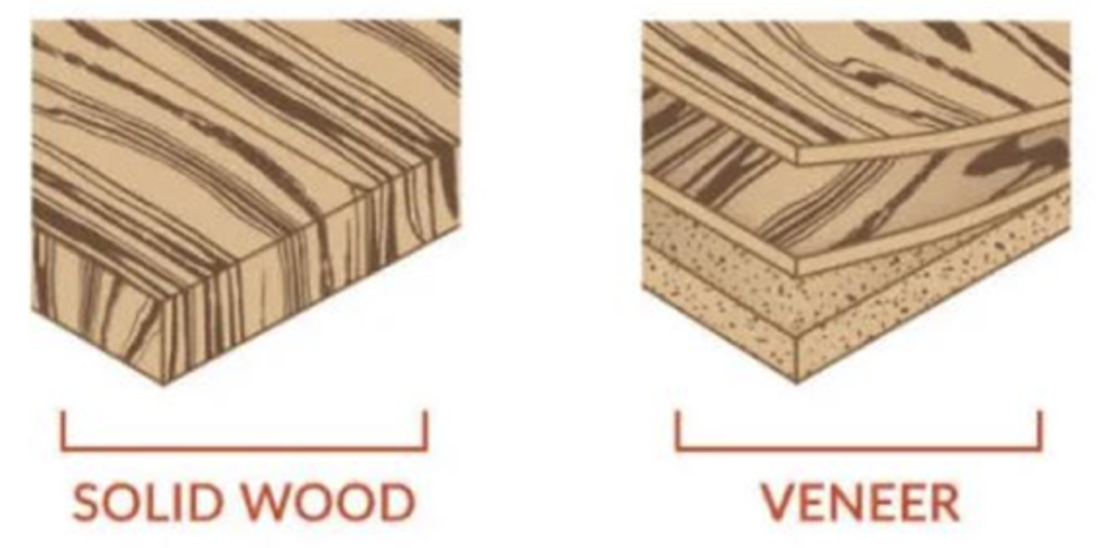
I recently refinished an old oak desk, and the water damage had soaked through the entire veneer. Pieces with veneer have short shelf lives and low resale value. For reference, you can get 15x19” of solid walnut wood for about $100. Just 15x19” of walnut veneer costs about $6 -- particleboard is also pennies.
As for the metal base, it’s an antique brass finish, meaning it’s only brass plated. I don’t know much about the economy, but I feel like you could use the real stuff and you’d still have some money left over.
My primary gripe is with the way the product is advertised – “side table, walnut, antique brass”. You have to go into the details of the piece to learn that it is only superficially either of those things. I feel like they’re tricking young millennials who don’t spend their free time on r/woodworking into thinking they’re getting durable & well-made MCM furniture, when they’re actually getting Aliexpress garbage.
This piece also just doesn’t seem sturdy. Although I have been known to take my laptop in the bath, I wouldn’t put like, a nice wine glass on this thing.You can actually get this on aliexpress btw. I think the design is OK – it’s just overpriced for the materials.
Then there is the mango wood. Honestly this feels like the scam of the (mid) century. They have a variety of side tables, desks, and coffee tables in this wood from mango trees. It’s solid wood (not a veneer), so big props to west elm there. Apparently they get it from crusty old mango trees that have been sucked dry by the ferocious mango economy in India.
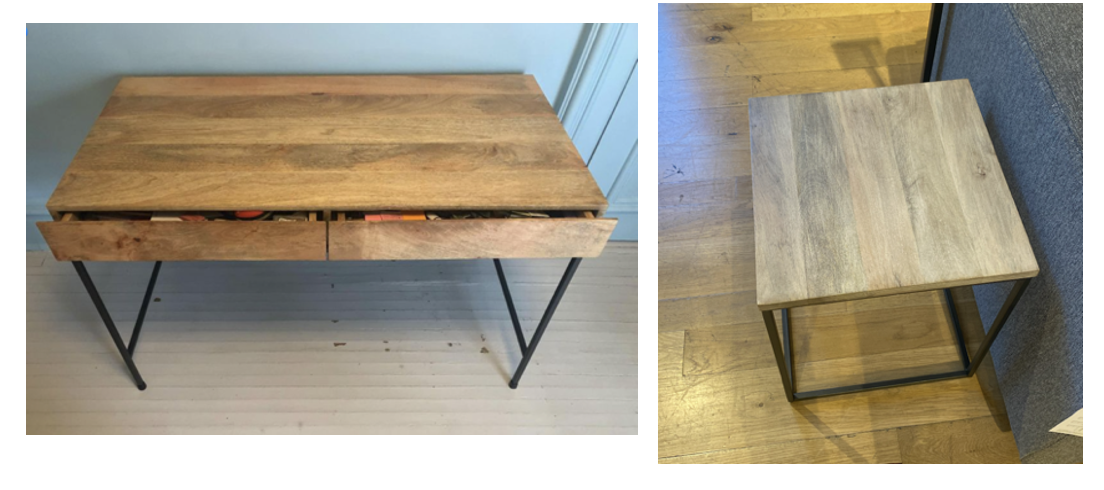
I’m sure the mango wood is somewhat sustainable (as they advertise relentlessly) but.. it’s just so ugly?? The wood grain is reminiscent of water-damaged pine. There’s no continuity in color or pattern, and there’s a real presence of cool, bluish undertones that makes it look like a weathered deck.
It just looks dirty! But the geniuses at west elm have found another word for that… these pieces aren’t ugly… they’re industrial:
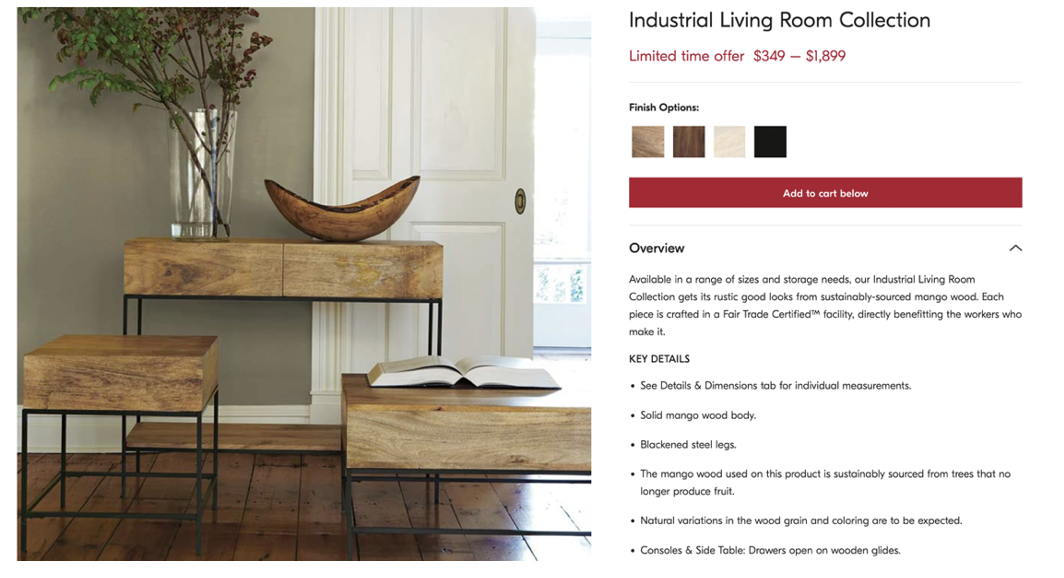
The price on some of these pieces... jail!!
$700 for the coffee table alone. These are mahogany prices, people! I once saw someone who listed their mango west elm desk on Facebook marketplace for the original price – $500 – and the listing stayed there for months (it’s still up actually). Like, sorry you got scammed, but don’t make that our problem.
This person’s inability to resell their desk on marketplace I think actually touches on the core business model of west elm. Nothing is actually nice – it’s just on-trend and well-staged. The value is completely artificial. And I GET that like, that’s how capitalism works. I’m just annoyed that the scam is so obvious here. They must think we’re suckers.
The mango is a hardwood, which makes it more durable (unlike pine, which is a softwood and will dent, scratch, etc.). Although apparently they didn’t bother with a good finish– the regular showroom wear and tear is very visible.
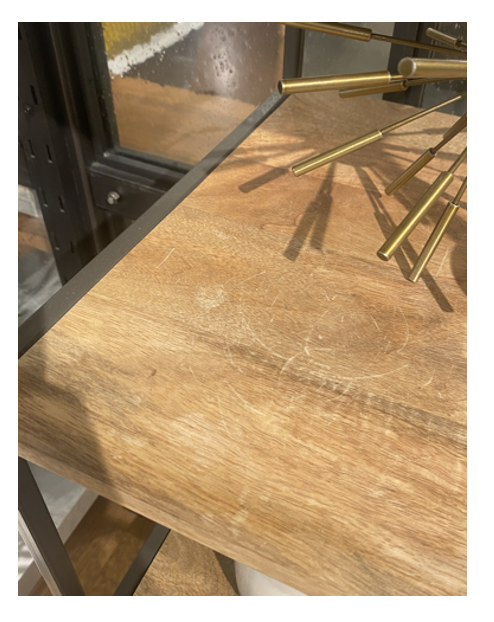
The mango takes stain pretty well, though, and their other mango coffee table with a dark, walnut stain is much nicer. Still outrageous prices, but at least the stains hide some of the awful coloring.

Their other furniture seems.. good? A lot of leather MCM lounge chairs, which look comfortable and stylish. I’m not a leather connoisseur. Their other stuff like vases, rugs, and pillows seem extremely generic but they’re nice I GUESS. I want to see those margins.
Disillusioned by west elm, I decided to go to restoration hardware (RH) – west elm’s rich, conservative aunt. I gotta say, RH has some fantastic pieces of furniture if you are a giant who loves a monochromatic color scheme. And that’s a compliment! Let’s start with the wood (a topic in which I am a seasoned critic, to which you can now attest):
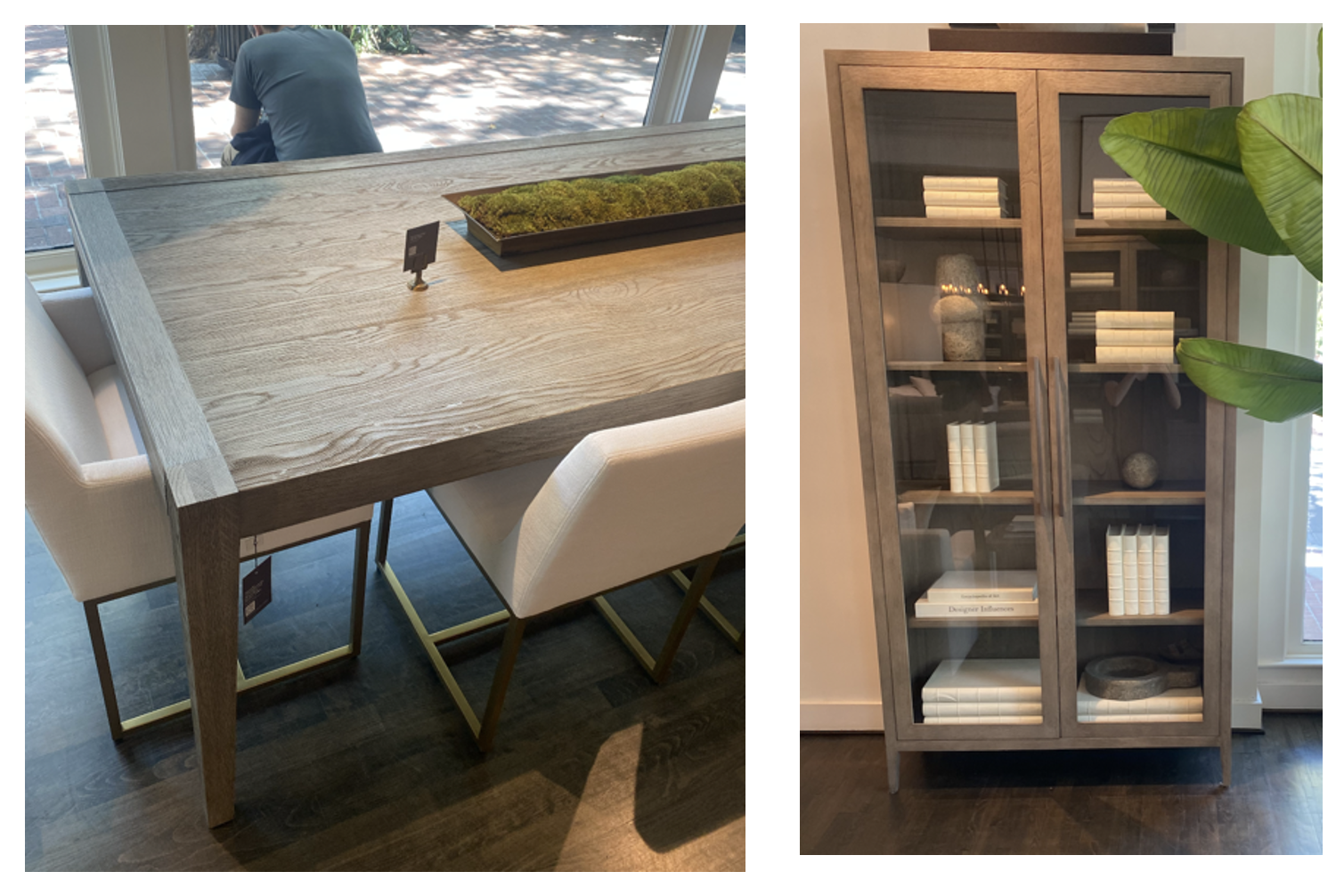
RH has some simple but classic wood pieces in their current collection (I think that’s how it works? Like there’s a new collection each season?). My favourite is an 8-foot tall oak cabinet with glass panes. They also have a very assertive dining room table – also like 10 feet long, which echoes the clean lines and sharp angles of the cabinet.
My one qualm is what they’ve done to the wood itself. It’s made of solid oak (score) that’s been sandblasted “to impart a subtle texture” and stained a “brushed grey oak” color. That all sounds very fancy, so why do I feel like I’m sitting at a table in a Rainforest Café?

The sandblasting creates these deep grooves in the wood, which, combined with the heavy finish, gives the oak a plastic feel. It just feels tacky, which is too bad because I’m sure the table will last a while. That said – seems like a pain to clean.
As for the rest of their furniture, I am a fan. But I can’t emphasize how big this stuff is. I honestly don’t think these couches would fit through a standard door frame. It’s very American.
The prices at RH I can at least understand. The coffee tables are hand-crafted with oak sourced from old buildings (which they advertise more subtly - as if their sustainability is a given). Their target demographic is also rich people who want to look rich, so I don’t really care about any scammery that’s happening. I also appreciate that RH has its own identity and legacy and could survive without targeted advertising and Instagram.
On the other hand, west elm is close to home. They’re targeting millennials, who just want to spruce up their rental apartment. Their scam is painfully ironic: piggybacking on MCM design with none of the quality or affordability that originally defined the era.
The great thing about original MCM pieces is that they’re often made of solid wood and designed to last. There’s a hot market for restoring old wood furniture, and MCM pieces are some of the top sellers at the moment. If you see something at west elm that catches your eye, I implore you to look for an equivalent refinished piece. It will be slightly more expensive than west elm, but you won’t be scamming someone else if you resell it.
Noodle the Bones Dog Just Dropped Merch
TikTok has silently and forcefully sucked me in. For those who have avoided its gravitational pull, TikTok is an app that shows you videos ranging from 15 seconds to 3 minutes. If you don’t like a video, you can keep scrolling. But TikTok will remember. It uses the length of time spent watching a video, along with your engagement with the video (whether you liked it, or commented) to train its algorithm that predicts, essentially, you. The speed and accuracy of the algorithm is disturbing. Somehow, within hours of using the app, TikTok had me pegged. TikTok is leagues ahead compared to the targeted ads I get on Instagram:

It’s easy to lose hours to TikTok. If you’re looking to avoid the possibility of having a single thought, TikTok provides. The range of emotions elicited from 1 hour of watching TikTok exceeds anything I’ve experienced on other social media sites. One moment I’m enraged, watching a woman document the state of her home as it falls into disarray when she stops picking up after her husband (#wifestrike). Then, I’m giggling watching my favorite comedian talk about how 3 Mike’s Hard Lemonades is stronger than any psychedelic you can buy. Eventually, I’ll stumble upon a devastating video of an old dog’s final days before euthanasia. It’s psychotic.
Recently, a man went viral for posting daily videos of his senile pug immediately after lifting him out of bed. If the pug keeps himself upright after he’s released, he “has bones,” and “it’s a bones day”. A bones day is an exceptionally good omen; you should treat yourself to that thing you’ve been eyeing, ask for the raise, take the risk. If the pug slumps back into his bed, then it’s a no-bones day; time for self-care, take it easy, don’t rush into anything. This horoscope for the new millennia has gripped Twitter as well, with accounts popping up to announce to the world whether it’s a bones or no bones day.

This is the death rattle of a society in decline.
I’m kidding, of course. I love a good internet phenomenon that unites the masses in silliness. But what does it mean that this guy’s first instinct is to make merchandise, and we’re all like, yup! Only logical next step!
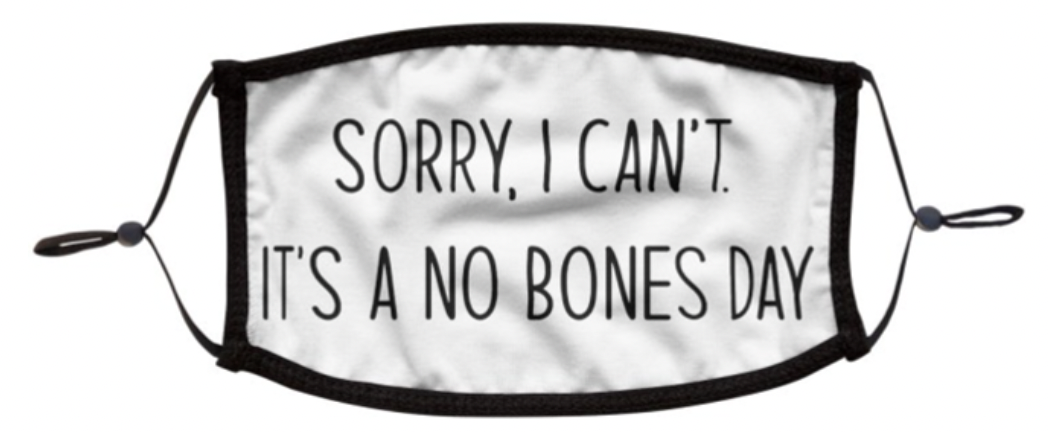
The mask costs $25 by the way. Part of me wonders about the scope of phenomena like this when the internet is so politically divided. Does my conservative aunt know about bones day? Will I remember this pug in 3 years? Do you think the Romans had an equivalent of this? At least they had chariot races. All the technology of the 21st century, and we’re enthralled by whether some pug on his deathbed gives life one more shot?
With amplification algorithms tuned to maximize engagement for the sake of beefing up the bottom line, social media is increasingly a self-perpetuating distraction machine. I may be on Twitter, but I’m still angry about people’s obsession with a TikTok meme, reacting to the reactions. Our outrage, joy, and nihilism are all high-octane fuel for the attention economy, manufactured by and for our own consumption. Can’t we just take a break, and stop this endless cycle of content farming? It’s a no bones day, after all.
My nested cross-validation come to Jesus moment
Tucked away in the last figure of a multivoxel pattern analysis review article lies the best visual depiction of nested cross-validation I’ve ever encountered. Behold:
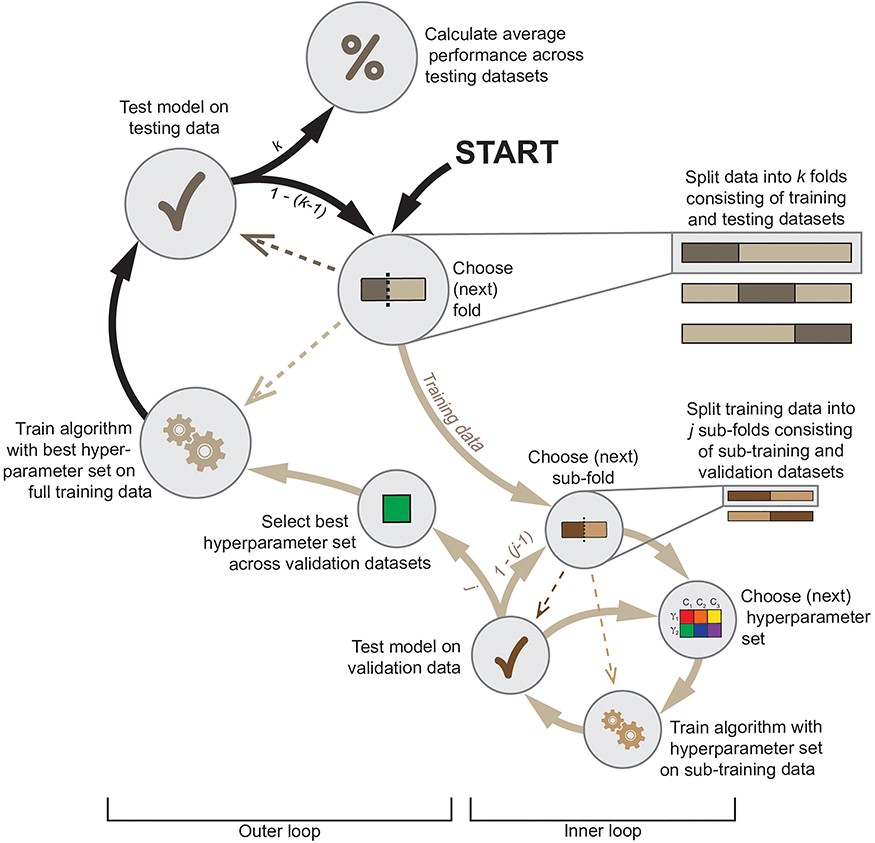
Have you ever seen something so beautiful? Approaching machine learning from a neuroscience background has often left me frustrated as I often feel like I'm missing crucial, simple details that would make everything "click", something I attribute to not taking enough computer science courses during my undergrad.
With nested-cross validation, I always had questions like: how are hyperparameters evaluated in the inner loop? How do the best hyperparameters get worked back into the outer loop? What is the specific order of operations?
This graphic answers all my questions, so I wanted to share. Enjoy.
Too much mindfulness?

As someone who has always believed that their life would improve dramatically if only they could find the self-discipline to sit down and meditate for 10 goddamn minutes a day, I was shocked and somewhat amused to read a blog post about the dangers of too much mindfulness. In it, Dan Lawton documents his experience meditating so deeply that he descended into a ‘hellscape of terror, panic and paranoia,’ an episode so traumatic that it left him with PTSD and a rightful sense of betrayal from the meditation community. How could this happen? I was really banking on Nirvana being more welcoming.
As it turns out, there’s an upper limit to the benefits you can extract from meditation and mindfulness before you start seeing “side effects”. On his quest for answers, Lawton discovered the recent work of Dr. Willoughby Britton, a psychologist at Brown, who has been warning of the potential dangers of mindfulness for the past decade. She runs “First Do No Harm” trainings for meditation retreat centers, which I can’t imagine is very good PR for them.
Her work outlines primarily the domains of mindfulness-related practices and how certain people may actually be harmed by taking these on, depending on their baseline psychological characteristics. For instance, interoception, or awareness of the internal body state, is a mindfulness-related skill thought to confer the most benefits from mindfulness (Mehling et al., 2012). Increased interoception resulting from mindfulness has been linked to increases in the activation and cortical thickness of the insular cortex, the primary hub for interoception. Britton points out that increased awareness of your body’s internal sensations is not necessarily a good thing. Are we really recommending everyone should be more in tune with their body’s sensations of hunger, chronic pain, panic? What is the limit? Heightened awareness of arousal is believed to underlie some panic disorders (Clack 1986). Anecdotally, I wouldn’t want to be more in tune with my body’s alertness after I drink too much coffee.
I like the idea that mindfulness/meditation should be prescribed to meet a person's needs, and is not a 'cure-all' for everyone. If you're already feeling detached from your emotions, maybe putting more distance between your awareness and your thoughts is not a good thing, and likewise for high baseline self-awareness.
Someone who copes by numbing out or repressing their emotions might not benefit from further distance between their awareness and their feelings. On the other hand, someone who over-identifies with their emotions to the point of getting lost in them might stand to gain from detachment techniques.
The story makes me realize that mindfulness & meditation is just another market filled with people who are looking to make a profit, and perhaps there should be more filtering of who would actually benefit from meditation/mindfulness retreats in the way that psychedelic therapies screen against people with family histories of psychosis.
The major take home for me was that balance, or the 'middle way', as the author puts it, might be the only thing worth striving for.